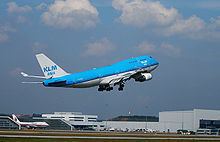Passengers 231 Fatalities 0 Date 15 December 1989 Passenger count 231 | Crew 14 Injuries (non-fatal) 0 Number of deaths 0 Survivor 245 (all) | |
 | ||
Similar British Airways Flight 9, United Airlines Flight 811, Partnair Flight 394, Varig Flight 254, KLM Flight 861 | ||
On 15 December 1989, KLM Flight 867, en route from Amsterdam to Narita International Airport Tokyo, was descending to Anchorage International Airport Alaska when all four engines failed. The Boeing 747-400 combi, less than six months old at the time, flew through a thick cloud of volcanic ash from Mount Redoubt, which had erupted the day before.
Contents
Engine failure
All four engines failed, leaving only critical systems on backup electrical power. One report assigns the engine shutdown to the turning of the ash into a glass coating inside the engines that fooled the engine temperature sensors and led to an auto-shutdown of all four engines.
When all four main generators shut off due to the failure of all the engines, a momentary power interruption occurs when the flight instruments transfer to standby power. Standby power on the 747-400 is provided by two batteries and inverters. The captain performed the engine restart procedure, which failed on the first few attempts, and repeated it until restart was achieved. On some of the attempts, as one or more (but not all) engines started to operate, the main generator switched back on. This switching on and off caused repeated power transfer interruptions to the flight instruments. The temporary blanking of the instruments gave the appearance that standby power had failed. These power transfers were later verified from the flight data recorder.
Transcript
The following edited transmissions took place between Anchorage Center, the air traffic control facility for that region, and KLM 867:
Pilot: KLM 867 heavy is reaching level 250 heading 140Anchorage Center: Okay, Do you have good sight on the ash plume at this time?Pilot: Yea, it's just cloudy it could be ashes. It's just a little browner than the normal cloud.Pilot: We have to go left now: it's smoky in the cockpit at the moment, sir.Anchorage Center: KLM 867 heavy, roger, left at your discretion.Pilot: Climbing to level 390, we're in a black cloud, heading 130.Pilot: KLM 867 we have flame out all engines and we are descending now!Anchorage Center: KLM 867 heavy, Anchorage?Pilot: KLM 867 heavy, we are descending now: we are in a fall!Pilot: KLM 867, we need all the assistance you have, sir. Give us radar vectors please!Listen on this television broadcast to the actual cockpit audio recording: phys.org
Recovery and aftermath
After descending more than 14,000 feet, Captain Karl van der Elst and crew restarted the engines and safely landed the plane. In this case the ash caused more than US$80 million in damage to the aircraft, requiring all four engines to be replaced, but no lives were lost and no one was injured. A shipment of 25 African birds, two genets, and 25 tortoises aboard the plane was diverted to an Anchorage warehouse, where eight birds and three tortoises died before the mislabeled shipment was discovered.
As of April 2016, the aircraft is still in service with KLM, but no longer carries KLM Asia livery as it was repainted in KLM livery after a maintenance check in 2012.
Similar incidents
In a nearly identical incident on 24 June 1982, British Airways Flight 9 from London Heathrow to Auckland, while on the leg from Kuala Lumpur to Perth, Western Australia, flew into a cloud of volcanic ash from the eruption of Mount Galunggung, causing all four engines to fail due to compressor stall. The aircraft was diverted to Jakarta, and glided out of the ash cloud, restarted its engines (although one failed again shortly), and landed safely.
